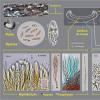
04-11-2025 09:07
Hello.A suspected Hymenoscyphus sprouting on a thi

04-11-2025 12:43
 Edvin Johannesen
Edvin Johannesen
Hi! One more found on old Populus tremula log in O

03-11-2025 21:34
 Edvin Johannesen
Edvin Johannesen
These tiny (0.4-0.5 mm diam.), whitish, short-stip

28-10-2025 15:37
Carl FarmerI'd be grateful for any suggestions for this strik

03-11-2025 16:30
 Hans-Otto Baral
Hans-Otto Baral
Hello I want to ask you if you have found this ye

28-10-2025 19:33
 Nicolas Suberbielle
Nicolas Suberbielle
Bonjour à tous,Je voudrais votre avis sur cette r
Psilachnum possible # 50678
Roland Labbé,
06-05-2017 01:32
Voici possiblement un Psilachnum.
Nous vous remercieons de nous aider à l'identification de ce disco.
Amitiés !
Roland
Données :
Date de récolte : 23 / 10 / 2015
Substrat : bille de feuillu en décomposition au sol d'une forêt de feuillus
Apothécie jusqu'à 0,8 mm de diam., cupuliforme, étroitement sessile, hyaline à blanchâtre, à marge finement ornée de poils hyalins couverts d'incrustations réfringentes dorées
Spores étroitement ellipsoïdes à cylindriques, parfois légèrement arquées, lisses, non septées, avec 2 ou 3 petites guttules, hyalines réfringentes, 5,9-7,1 x 1,6-1,9 µm, Q = 3,8
Asques cylindriques, à 8 spores bisériées, avec crochet basal et pore apical amyloïde, à contenu dextrinoïde, 31,8-38,4 x 4-5 µm
Paraphyses cylindriques, non ramifiées, parfois légèrement renflées vers l'apex, avec un septum au tiers inférieur, à contenu difficile à préciser (exsiccatum), hyalines, 37,2-45,2 x 1,2-2,4 µm
Medulla en textura epidermoidea/angularis, formée de cellules gélatinisées, hyalines
Excipulum ectal en textura angularis, formé de cellules à paroi légèrement épaissie, hyalines, 6-9 x 3,2-7 µm
Poils marginaux dispersés, lancéolés, non septés, hyalins, couverts d'une substance incrustante réfringente d'aspect doré, à contenu apical granuleux réfringent, 29-50 x 3,4-5,4 µm
Hans-Otto Baral,
06-05-2017 09:55

Re : Psilachnum possible # 50678
Hi Roland
as always, in the living state it would be much easier.
I consider this to be a Hyaloscypha, based on the hairs and lignicolous habitat.
Psilachnum would be recognizable, e.g., by its VBs in the living paraphyses and hairs.
Zotto
as always, in the living state it would be much easier.
I consider this to be a Hyaloscypha, based on the hairs and lignicolous habitat.
Psilachnum would be recognizable, e.g., by its VBs in the living paraphyses and hairs.
Zotto



